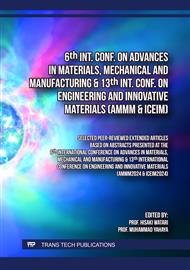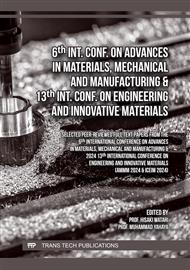[1]
Mr A M A, Mr H E A. The manufacturing practices and parameters optimization on abrasive jet machining for surface preparation of mild steels[J]. Results in Engineering, 2022, 15: 100457.
DOI: 10.1016/j.rineng.2022.100457
Google Scholar
[2]
Guo R, Zhou C, Yuan S. Influence of abrasive water jet parameters on steel surface[J]. JOM, 2020, 72: 4273-4280.
DOI: 10.1007/s11837-020-04030-w
Google Scholar
[3]
Li C, Jia X, Wu S, et al. The Removal Mechanism Considering the Shape and Size of Abrasive Particles in Wet Blast Cleaning of Paint[J]. Sustainability, 2022, 14(21): 14289.
DOI: 10.3390/su142114289
Google Scholar
[4]
Madhukar Y K, Mullick S, Nath A K. Development of a water-jet assisted laser paint removal process[J]. Applied surface science, 2013, 286: 192-205.
DOI: 10.1016/j.apsusc.2013.09.046
Google Scholar
[5]
Ning D, Wang Q, Tian J, et al. Experimental study on the coating removing characteristics of high-pressure water jet by micro jet flow[J]. Micromachines, 2021, 12(2): 173.
DOI: 10.3390/mi12020173
Google Scholar
[6]
Sourd X, Zitoune R, Hejjaji A, et al. Plain water jet cleaning of titanium alloy after abrasive water jet milling: Surface contamination and quality analysis in the context of maintenance[J]. Wear, 2021, 477: 203833.
DOI: 10.1016/j.wear.2021.203833
Google Scholar
[7]
Zou X, Fu L, Wu L. Multiphase flow and nozzle wear with CFD-DEM in high-pressure abrasive water jet[J]. Powder Technology, 2024: 120019.
DOI: 10.1016/j.powtec.2024.120019
Google Scholar
[8]
Zhang J, Yang X, Sagar S, et al. Smoothed Particle Hydrodynamics Modeling of Thermal Barrier Coating Removal Process Using Abrasive Water Jet Technique[J]. Journal of Manufacturing Science and Engineering, 2022, 144(9): 091012.
DOI: 10.1115/1.4055048
Google Scholar
[9]
Chen Y J, Chen Z S, Zhao W T, et al. Optimisation strategy to enhance the performance and efficiency of self-rotary water-jet derusting sprayers[J]. Ocean Engineering, 2024, 303: 117620.
DOI: 10.1016/j.oceaneng.2024.117620
Google Scholar
[10]
Liao H L, Jia X, Niu J L, et al. Flow structure and rock-breaking feature of the self-rotating nozzle for radial jet drilling[J]. Petroleum Science, 2020, 17: 211-221.
DOI: 10.1007/s12182-019-00378-0
Google Scholar
[11]
Huang S, Huang J, He K. Research on Erosion Effect of Various Submerged Cavitating Jet Nozzles and Design of Self-Rotating Cleaning Device[J]. Applied Sciences, 2024, 14(4): 1433.
DOI: 10.3390/app14041433
Google Scholar
[12]
Song C, Cui W. Review of underwater ship hull cleaning technologies[J]. Journal of marine science and application, 2020, 19(3): 415-429.
DOI: 10.1007/s11804-020-00157-z
Google Scholar
[13]
Marcobal J R, Salado F, Flintsch G. Evaluation of Various Surface Cleaning Techniques Inside Tunnels on Pavement Skid Resistance[J]. Materials, 2021, 14(19): 5660.
DOI: 10.3390/ma14195660
Google Scholar
[14]
Bhagat R K, Perera A M, Wilson D I. Cleaning vessel walls by moving water jets: Simple models and supporting experiments[J]. Food and Bioproducts Processing, 2017, 102: 31-54.
DOI: 10.1016/j.fbp.2016.11.011
Google Scholar
[15]
Wang Q, Ning D, Hou J, et al. Particle kinetic energy-based modeling and experimental study on abrasive waterjet coating removal[J]. Journal of Cleaner Production, 2024, 444: 141108.
DOI: 10.1016/j.jclepro.2024.141108
Google Scholar



